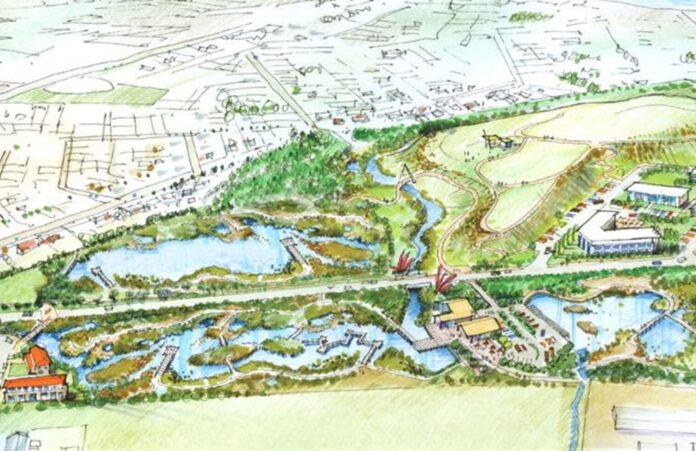Whanganui District Council says the region has an opportunity to lead the way globally with a Hapū-led approach to wetland development that not only benefits the environment but also supports cultural aspirations.
Whanganui District councillors heard at a recent full council meeting that the Mokoia Catchment Rōpu (MCR) was formed at the end of last year to guide and support the development of the Kokohuia and Titoki wetlands in Castlecliff from both a cultural and community focused perspective.
As well as Whanganui District Council involvement, MCR includes Whanganui and Ngā Rauru Kītahi Hapū, community stakeholders and Ngā Tangata Tiaki o Whanganui, along with Te Mata Puau (a Hapū collective for Te Pūwaha, the Whanganui Port project).
The master plan for the restoration of the wetlands is being guided by internationally recognised legislation, the Te Awa Tupua Settlement Act that gave the Whanganui River its own personhood, and the act’s values – Tupua Te Kawa.
The four Kawa under the act are:
- Ko te Awa te Mātāpuna o te ora
(The river is the source of spiritual and physical sustenance) - E rere kau mai i te Awa nui mai i te Kāhui Maunga ki Tangaroa
(The great river flows from the mountains to the sea) - Ko au te Awa, ko te Awa ko au
(I am the river and the river is me) - Ngā manga iti, ngā manga nui e honohono kau ana ka tupu, hei Awa Tupua
(The small and large streams that flow into one another and form one River)
The Act itself is an international first and provides an Indigenous framework to inform wetland development which is also an international first.

A report presented at the meeting on 26 March said that not only was the act a global first, but was also a first internationally by providing an indigenous framework to inform wetland development. This would set a precedent worldwide for future development and income opportunities, Councillors were told.
MCR representative, Ken Mair, speaking at the meeting, said the wetland development was a significant opportunity internationally, nationally, and locally. However, the real opportunity was improvements to the health and wellbeing of the wetlands that would mean the return of tuna, inanga and manu (eels, whitebait and other native freshwater species and birds) to the area.
“We have a responsibility to ensure we look to the future of returning that area to what it was – it’s going to be a challenge,” Mr Mair said.
Te Repo o Kokohuia, and the interconnected wetland system extending to the Titoki Street repo (swamp), is an area of great historical significance to Whanganui and Ngā Rauru Kītahi Iwi. It was once a thriving wetland that provided mahinga kai (plant, aquatic and native bird life) food gathering sites, resource materials (harakeke) and rongoa (medicinal plants) for whānau, marae and Hapū that traditionally lived there.
The report said that as a result of urban development, over the years much of the wetland has been destroyed and degraded and connection to the awa cut off. Part of the area was also filled in when it became the Balgownie rubbish dump. The landfill closed in 2000 and final capping was completed in March 2001.
Hapū has been involved in a series of workshops and community meetings about the development of Kokohuia wetlands since 2013.
The report said MCR fully supports the positive ecological, recreational, water quality and flood management outcomes the Kokohuia / Titoki development will provide, but of greater importance will be the achievement of collective Hapū cultural aspirations and vision for the repo (area).
Hapū aspirations include the ecological reconnection of the repo to the awa, creating a native freshwater fish spawning habitat, ensuring there is no contamination or leaching from the former Balgownie landfill, and greater community connectivity, recreational and educational amenities to provide the history and cultural significance of the repo to Iwi and Hapū.
Te Kura o Kokohuia, located next to the repo, is also playing a significant role in restoration efforts, Ken Mair said.
Council Three Waters manager, Kritzo Venter says modelling has shown that the Kokohuia and Titoki wetlands had a positive impact on reducing flooding in the Heads Road area and created significant stormwater retention.
The wetlands will provide robust treatment of stormwater run-off before any discharge into the tidal reaches of the Whanganui River and help to mitigate any increased stormwater run-off from new housing developments in the Springvale area, he said.
Mr Venter says one of the master plan’s major challenges is to manage historical and outgoing impacts of the former landfill next to the Kokohuia wetland.
Landscape architect, Craig Pocock, who also spoke at the meeting, has been involved in development of the master plan for the past decade. He described Kokohuia as a “significant physical and cultural landscape.”
The next steps for the wetland development project include re-engaging with the community and investigating public funding sources based on international interest in this work under Te Awa Tupua legislation. Some funding is available for wetland improvement work in the council’s existing stormwater budgets.
More information about the draft master plan can be found here.



